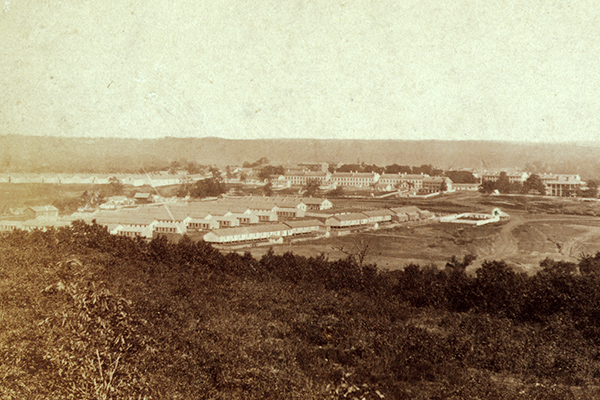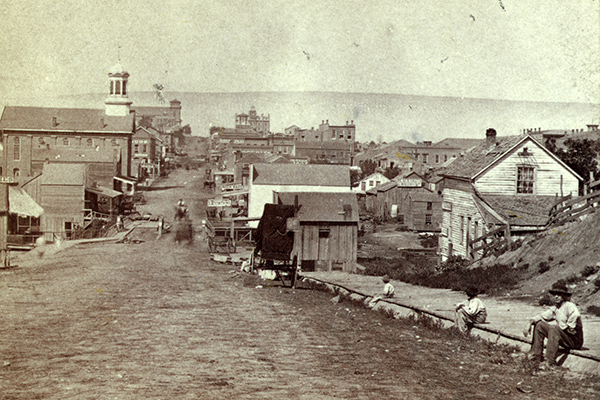By Marc Reyes, University of Connecticut
On March 7, 1827, Colonel Henry Leavenworth received his order to proceed “with four companies of his regiment, ascend the Missouri,” and find a point “on its left bank near the mouth of the Little Platte River and within a range of twenty miles above or below its confluence.” From there, Colonel Leavenworth would “select such position as in his judgment is best calculated for the site a permanent cantonment.”
After two months of surveying the area, Colonel Leavenworth found what he was looking for: an area located strategically near the Missouri River but not in danger of being flooded by it. As Leavenworth and his men dug and constructed the first living quarters of this new military installation, none of the men, not even the namesake of the fort, could have imagined that they were breaking ground on a fortification that would go on to operate across three centuries of American history. Fort Leavenworth carries the proud distinction of being the oldest post west of Washington, D.C., that remains in continuous operation.
It is impossible to divorce Fort Leavenworth from its namesake town that was established nearly three decades after the fort. At the time of the town of Leavenworth’s formal founding in 1854, the fort was already a witness to the growing conflict of slavery and the problems posed by its possible expansion west. Just outside the confines of the fort, the nearby town’s residents adopted a proslavery stance and helped found the proslavery Law and Order Party.
Despite such rousing proslavery sentiment, Leavenworth did possess a number of fervent abolitionists. Their advocacy resulted in everything from using the town’s name when titling the most radical antislavery state constitution produced during the “Bleeding Kansas” era to the creation of a secret network of underground passages and buildings most likely used to transport runaway slaves who sought freedom along the Underground Railroad.
When the Civil War started, Fort Leavenworth was awash in a sea of proslavery sentiment.Even with such striking abolitionist actions, they could not impede the power of proslavery forces. When the Civil War started, Fort Leavenworth was awash in a sea of proslavery sentiment. The areas surrounding the fort, including Leavenworth as well as northeastern Kansas and northwestern Missouri, were strongholds for Confederate sympathizers. But Union officials quickly realized the strategic value of the fort. From its position in hostile territory, Fort Leavenworth served as the crucial training station for Kansas’s volunteers, and even until late in the war the fort prepared for possible attack. The fort came to represent the Union’s best hope of preventing Confederate military control over the region.
Besides the previously mentioned bounty of geographical benefits, Fort Leavenworth was equipped with two other key qualities: a well-stocked armory and its experience as a top training center for new Army recruits. The armory’s great stockpile not only provided badly needed ammunition to the Union cause, but it also resupplied smaller forts such as Fort Riley and Fort Laramie. Without Fort Leavenworth providing such critical services, both forts could have fallen under Confederate command and given the Confederate Army near total control of eastern Kansas and western Missouri. Instead, Fort Leavenworth remained one of the few military sites on the Western Border to never experience a Confederate attack.
Fort Leavenworth’s second quality, as an Army training center, played a far bigger role during the course of the Civil War. During the Mexican-American War between 1846 and 1848, the fort developed a strong reputation for producing excellent soldiers. Army leaders recognized the skills provided by the fort’s leadership and for the Civil War chose the fort as a place for exceptional new recruits to prepare for war. During the course of the war, a new day would bring in scores of new recruits, and by the end of the struggle, thousands had arrived at Fort Leavenworth and left as well-trained soldiers fighting for the Union cause.
Today the fort’s name brings to mind several images. To military historians and scholars studying race, Fort Leavenworth was the home of the “Buffalo Soldiers,” the first regular, peacetime Army regiments fully composed of black soldiers after the end of the Civil War. Building on the courage and devotion to duty that black soldiers demonstrated during the war, Army officials recognized the necessity and value of an official standing unit of black soldiers and formed four regiments in 1866.
In the 20th century, a federal prison, a veteran’s hospital, and a national cemetery were added to the already large military installation. As valuable as the fort was during the Civil War, the fort was even more vital for its role in the post-Civil War “Indian Wars” that occurred in the latter half of the 19th century. Through the many years of Fort Leavenworth’s existence, countless American soldiers have received an extensive education at the United States Army Training and Doctrine Command and the United States Army Combined Arms Center.
Continuing its reputation as “the intellectual nerve center of the United States Army,” the installation has trained and educated a staggering number of brilliant military strategists. Military luminaries such as Dwight Eisenhower, Omar Bradley, and George Patton have walked through Fort Leavenworth’s doors and left with the preparation necessary to lead men into battle. Here the men who commanded armies learned how to fight and how to inspire men willing to make what Abraham Lincoln called “the last full measure of devotion.” When Colonel Henry Leavenworth set out that fateful March morning in 1827, he was told to build “temporary quarters” for him and his men. At present, the post is 180 years old and has played a vital role in every major American conflict since the Civil War.
Suggested Reading:
Hughes, J. Patrick. Fort Leavenworth: Gateway to the West. Topeka, Kansas: Kansas State Historical Society, 2000.
Hunt, Elvid. History of Fort Leavenworth 1827-1937. Fort Leavenworth, Kansas: The Command and General Staff School Press, 1937.
Mullis, Tony R. Peacekeeping on the Plains: Army Operations in Bleeding Kansas. Columbia: University of Missouri Press, 2004.
Walton, George. Sentinel of the Plains: Fort Leavenworth and the American West. Upper Saddle River, New Jersey: Prentice-Hall, 1973.
Cite This Page:
Reyes, Marc. "Fort Leavenworth" Civil War on the Western Border: The Missouri-Kansas Conflict, 1854-1865. The Kansas City Public Library. Accessed Saturday, April 27, 2024 - 05:00 at https://civilwaronthewesternborder.org/encyclopedia/fort-leavenworth



